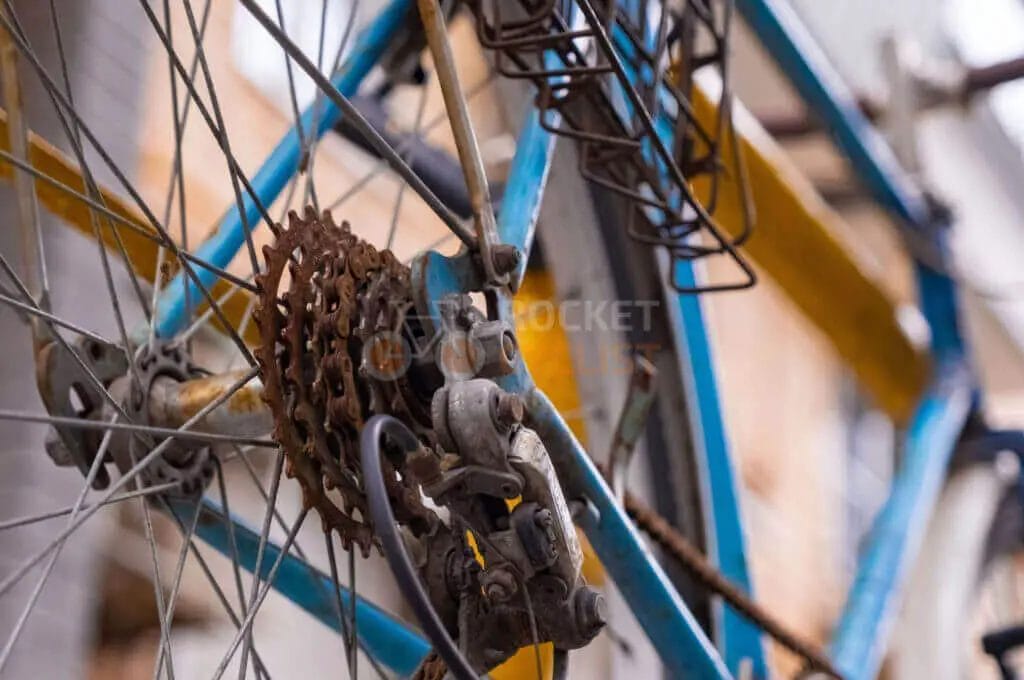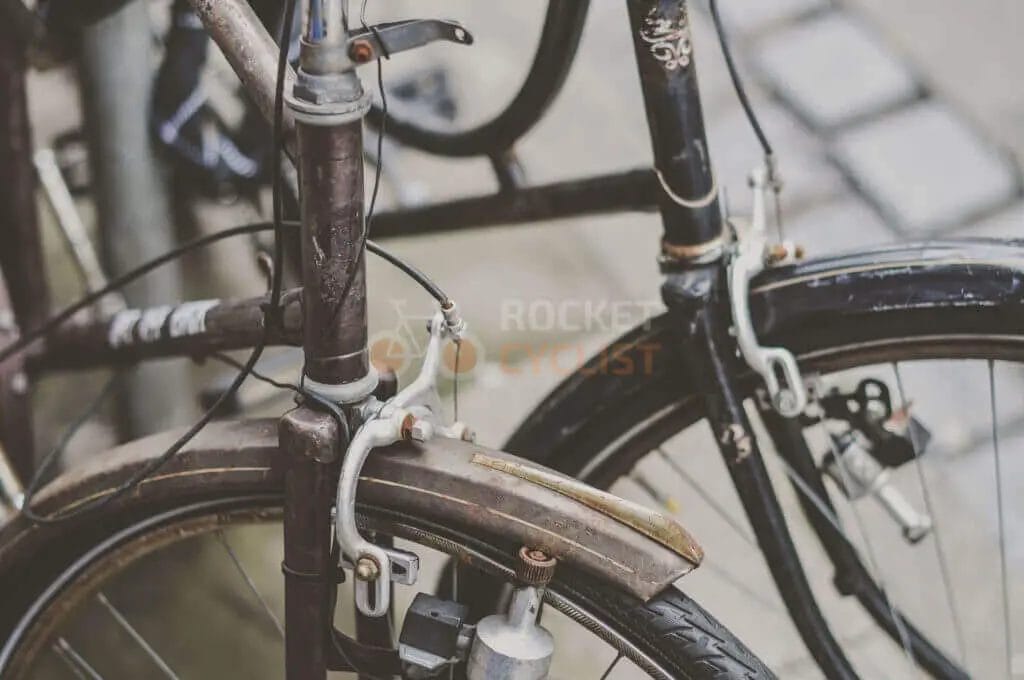Last Updated on March 27, 2024 by Vinson Lozano
Overview of Rust on Bicycle Parts

Bicycle enthusiasts would agree that maintaining the bike’s performance and appearance is crucial. However, bikes are susceptible to rust due to exposure to various weather conditions and humidity—a common enemy for metals. This inevitably leads to the presence of rust on your bike parts, putting your bicycle’s functionality at risk.
Understanding the Impact of Rust on Bicycle Performance
Rusting on bicycle parts is not just an aesthetic issue, but it could also degrade your bicycle’s performance. Rust, also known as iron oxide, occurs when iron or its alloys such as steel come into contact with water or moisture from the environment—a process known as oxidation.
Over time, this process can weaken the affected parts, render them less effective, and lead to wear and tear. For example, rust on the bike chain can cause it to be stiff, affecting its movement. A rusted brake system might not function correctly, compromising your safety.
Why It is Important to Remove Rust from Bicycle Parts

Removing rust from bike parts is more than just about maintaining the bicycle’s look; it’s about:
- Preserving the bike’s function: Removing rust helps maintain the effectiveness of rust-prone parts like chains, gears, and brakes.
- Safety: A rusted brake system or worn-out chain can cause accidents. Therefore, taking care of rust not only extends your bike’s life but also ensures safety.
- Longevity: Regular cleaning and rust removal extends the lifespan of your bike, giving you more years of smooth rides.
Stay tuned for our next section, where we delve into effective ways to remove rust from your bicycle parts.
Assessing the Rust Damage

When it comes to maintaining a bicycle, dealing with rust is part of the essential upkeep. Rust is an enemy for any bike enthusiast as it can degrade the performance and longevity of the bicycle parts. In this section, we will guide you on assessing the rust damage and identifying the severity of this unwanted corrosion.
Identifying Areas Affected by Rust
The first step to combat rust is identifying the affected areas. Rust usually accumulates on parts made of ferrous materials, such as steel. Typically, you will find rust on the bicycle chain, handlebars, spokes, frames, pedals, and other metal components. Look closely for any orange or brown discoloration. Keep in mind that early identification is key to prevent further damage.
Evaluating the Severity of the Rust Damage
Rust damage can range from surface rust that simply discolors the metal to severe rust that causes degradation of the part. To evaluate the severity, lightly rub the area with a cloth. If the corrosion wipes off, it’s only surface deep — a good sign. However, if the rust is penetrating into the metal, causing it to crumble or have holes, then this indicates severe damage that may require a replacement.
In the next sections, we’ll detail how you can remove the rust from your bicycle parts and restore your ride to its former glory. Remember, with the right maintenance and care, you can preserve your bicycle’s health for many more rides to come.
Tools and Materials Needed for Rust Removal

Getting rid of rust from your bicycle parts requires certain handy tools and materials to make the process smooth and effective. Let’s talk about the ingredients you’ll need in this rust removal mission.
Essential Tools for Rust Removal
Here are some primary tools required for rust removal:
- Wire Brush: This can help remove flaky rust particles from bicycle parts.
- Scraper or Putty Knife: These tools can scrape off the more stubborn areas of rust.
- Power Drill with Wire Brush Attachment: For tougher rust situations, this tool can make the scrubbing process effortless.
Recommended Materials for Effective Rust Removal
Additionally, some materials can boost the efficiency of rust removal from bicycle parts:
- Natural acids: These include lemon juice and white vinegar, which are effective rust dissolvers.
- Baking Soda: When mixed with water, it forms a paste that can effectively ward off rust.
- Commercial Rust Removers: Products such as WD-40 or Naval Jelly can come in handy for removing heavier rust.
Before using these tools and materials, make sure to take necessary safety measures, like wearing gloves and goggles to protect your skin and eyes. Choose the appropriate tools and materials based on the severity of the rust and the type of bicycle part you are cleaning.
Lastly, once the rust is removed, don’t forget to give your bicycle parts a fresh coat of paint or a rust-resistant finish to prevent future rust formation.
Preparing the Bicycle Parts for Rust Removal

Cleaning the Affected Parts
After identifying the rusty bicycle parts, the next step is cleaning the affected parts. You must remove all dirt and grime to ensure an effective rust removal process. Use a cloth and mild detergent to wipe down the targeted parts, or for tougher spots make use of a stiff-bristled brush. Make sure the parts are dry before moving onto the next step.
Disassembling Components if Necessary
If rust has invaded complex parts of the bicycle, such as the gear system or brakes, consider disassembling the components. This will allow for a more thorough cleaning and make it easier to get rid of the rust. However, before disassembling any parts of your bicycle, ensure that you are familiar with their assembly. If not, seek assistance from a professional or refer to online tutorials and manuals.
In summary:
- Clean the affected parts: Removing all dirt and grime will allow for a more thorough rust removal. Ensure the parts are dry before moving to the next step.
- Disassemble components if necessary: If the rusty parts are complex and hard to reach, consider disassembling them. Always ensure you’re familiar with the reassembly process.
Remember that regular maintenance of your bicycle can help to prevent the formation of rust in the first place. Regular wiping down, careful storage, and timely repairs can all contribute to a rust-free bicycle experience.
Methods for Rust Removal
Rust is the bane of any bicycle enthusiast. Nothing can ruin the appearance and function of your beloved ride like stubborn, creeping rust. Not to worry, though – there are several ways to tackle this issue and restore your bike’s former glory. Here’s an overview of the most effective rust removal techniques that both mechanical and chemical-based.
Chemical-based rust removal techniques
Chemical-based rust removal techniques involve using substances like vinegar, baking soda, or commercial rust removers to dissolve the rust. Here’s a brief rundown of these methods:
- Vinegar: Soak the rusted parts in white vinegar for a few hours, then scrub off the rust with a brush.
- Baking Soda: Mix baking soda with water to make a paste, apply it to the rusted areas, allow it to sit, and then scrub off the rust.
- Commercial Rust Removers: These are products specifically formulated to remove rust. They’re generally more powerful, but should be used with caution due to their corrosiveness.
Mechanical rust removal techniques
On the other hand, Mechanical rust removal techniques involve physically removing the rust from the surface. These methods can be slightly more labor-intensive but are often very successful:
- Sandpaper: Use coarse-grit sandpaper to rub away the rust. Be aware this technique can also remove paint or finish.
- Steel Wool or Wire Brush: This involves scrubbing the rusted area with a steel wool pad or wire brush.
The choice between chemical and mechanical techniques often depends on the severity of the rust and your personal preference. Remember to always wear protective gear when dealing with rust and corrosive substances.
DIY Rust Removal Solutions
Rust on bicycle parts can be a nuisance, but don’t worry! With some household items, you can free your bicycle parts from rust.
Using household items for rust removal
Whether you’re a DIY enthusiast or someone just trying to cut costs and avoid a trip to the repair shop, several household items can effectively remove rust. Here are some solutions you can consider:
- White Vinegar: The acidity in vinegar can dissolve rust. Just soak the rusted part in vinegar for a day or two, then scrub off the rust using a brush.
- Baking Soda: This versatile product can also get rid of rust. Make a paste by mixing baking soda with water, apply to the rusted area, leave it for a couple of hours, then scrub off.
- Citrus and Salt: Salt can boost the corrosive properties of citrus juice, making it more effective. Apply a salt and citrus mixture to the rust and let it sit for a couple of hours before scrubbing.
Step-by-Step Guide for Each DIY Rust Removal Method
- Determine the right solution: Depending on the number of rusted parts and their sizes, determine which household item is most feasible for you.
- Apply your chosen solution: Follow the above guidelines on how to apply each household item to the rusted areas.
- Wait and monitor: After applying the solution, wait for it to sit for a while. Check progress regularly to avoid over-corrosion.
- Scrub off the rust: Use a brush, old toothbrush, or steel wool to scrub the rust away gently.
- Rinse and dry: Rinse the parts with water to get rid of any residual solution, then dry them off to avoid additional rusting.
In conclusion, you can effortlessly remove rust from bicycle parts using household items. However, you can always resort to commercial rust removers if these methods do not work for the level or type of rust your bike parts have.
Commercial Rust Removal Products
When it comes to rust removal for bicycle parts, many cyclists opt for commercial rust removal products. These products are designed using a specific formula aimed at breaking down and eliminating rust efficiently.
Pros and Cons of Commercial Rust Removal Products
Pros:
- Effective: Most of these products are potent and can wipe off rust completely.
- Convenient: They are easy to apply and do not require major preparation.
Cons:
- Chemicals: Some products may contain harsh chemicals that could harm the bicycle’s finish or be harmful if not handled appropriately.
- Cost: Commercial rust removers may be more expensive compared to DIY methods.
Recommended Brands and Products for Bicycle Rust Removal
There is a variety of options available on the market today when looking for commercial rust removal products. Some notable ones include:
- Evapo-Rust : A non-toxic rust remover popular for its effectiveness and safety.
- WD-40: Known for its versatility, it helps displace moisture and remove rust.
- Rust-Oleum Rust Reformer: An easy-to-use spray that bonds with rust and transforms it into a paintable surface.
Always remember to prioritize safety when using these products and follow the manufacturer’s instructions for the best results.
In conclusion, commercial rust removal products can be a quick and handy solution for a rusty bicycle. However, the cyclist should consider the product’s potential chemical content, cost, and effectiveness before deciding.
Preventing Rust on Bicycle Parts
Rust can significantly affect the functionality and aesthetics of your bicycle. Fortunately, there are steps you can take to prevent rust from forming. Here are some essential tips and maintenance practices to keep your bike parts rust-free.
Tips and Tricks for Rust Prevention
1. Keep It Dry: Moisture is the main cause of rust. Make sure to dry your bike whenever it gets wet, especially after riding in rainy conditions.
2. Store It Properly: Store your bike in a cool, dry place. Avoid leaving it outside in rainy or snowy weather.
3. Use Anti-Rust Spray: Regularly apply an anti-rust spray on metal parts of your bike. This will create a protective layer that prevents rust formation.
4. Regularly Check for Signs of Rust: Detecting rust early can make it easier to deal with. Regularly inspect your bike for any signs of rust.
Maintenance Practices to Keep Your Bike Rust-Free
Clean Your Bike Often: Regular cleaning will not only keep your bike looking good but also reduce the chance of rust. Use a bike cleaner and soft cloth to clean off dirt and grime.
Lubricate the Chains: Lubricate the chains and other moving parts as these areas are especially susceptible to rust. A good lubricant reduces friction and keeps moisture away.
Schedule Regular Maintenance: Regular maintenance can ensure that all parts are in good condition and free from rust. If you spot small areas of rust, use a rust remover immediately.
In conclusion, rust prevention is all about regular care and maintenance of your bicycle. By following the tips and practices mentioned above, you can enjoy a rust-free ride for longer.
Replacing Irreparable Rust-Damaged Parts
There comes a time when rust damage is too significant, and it’s more feasible to replace bicycle parts rather than attempting to remove the rust. This usually occurs when rust has eaten through the material, causing structural instability, or when moving parts are too corroded to function properly.
When to consider replacing rust-damaged parts:
1. Significant Structural Damage: If the rust has caused holes or has weakened the structural integrity of the part, it’s safer to replace the part. In this case, attempting to remove the rust may lead to a dangerous situation where a critical part could fail while riding.
2. Impaired Functionality: Rust can bind moving parts together, making them stiff or impossible to move. If a simple thorough cleaning doesn’t restore function, replacing the part is the best alternative.
3. Extensive Surface Rust: Surface rust doesn’t necessarily affect performance, but it does make the bike look old and worn-out. If cleaning methods do not improve the bike’s appearance to your satisfaction, consider replacing the rusty parts.
Remember, safety is paramount. If you can visually see the integrity of a bicycle part compromised due to heavy rust, it’s time to replace it. Never risk your safety to squeeze a bit more life out of a severely rusted bike component.
Cleaning and Restoring the Bike’s Appearance
Removing rust from bicycle parts is a vital step in restoring the aesthetic appeal and functionality of the bike.
Polishing and Restoring the Affected Areas
After successfully removing the rust, polishing and restoring the affected areas should be the next action point. To accomplish this effectively, you need to:
• Clean the previously rusted parts with a mild detergent and water to remove any remaining rust, dirt, or cleaning solution.
• Dry the parts thoroughly using a clean towel.
• Apply a thin layer of automotive wax or a similar product to help protect the parts and restore their shine.• Buff the wax using a soft cloth until the parts regain their original gleam. This process not only returns the sheen to the affected areas but also provides a protective layer against future rust.
Maintaining the Bike’s Overall Aesthetic Appeal
Maintenance is the key to ensuring the bicycle’s overall aesthetic appeal. Always clean and check the bicycle regularly to detect any signs of rust or other forms of deterioration. This will help in timely identification and rectification of the problem, hence maintaining the bike’s look and functionality.
In conclusion, restoring a rusty bicycle involves rust removal, polishing, and regular maintenance. These steps help maintain the bike’s overall aesthetic appeal and increase its lifespan, offering the rider the best cycling experience.
Conclusion
It’s evident that removing rust from bicycle parts is not an overly complicated task. Provided you have the right tools and guidance, you can swiftly restore your bicycle to its former glory and prolong its life. Furthermore, this routine maintenance also ensures the safety and efficiency of your ride.
Final thoughts and tips for maintaining a rust-free bicycle
Maintaining a rust-free bicycle is quite achievable with a little effort and regular maintenance. Here are some important tips to keep in mind:
- Regular inspection: Check your bicycle frequently, especially after rainy days or long rides, for early signs of rust.
- Cleaning: Regularly clean your bicycle. Dust and grime can attract moisture, leading to rust formation. Use a specific bike cleaner and a soft cloth for best results.
- Proper storage: Always store your bicycle in a dry and moisture-free place. Leaving it outdoors or in damp places can quickly lead to rusting.
- Protective coatings: Use of corrosion inhibitors or oils can provide a protective film over the metal parts of your bicycle, making them less prone to rust.
In conclusion, the most effective way to prevent rust is through regular cleaning and protective maintenance. Remember, a rust-free bicycle not only looks good but also offers a smooth and safe ride. Happy biking!


